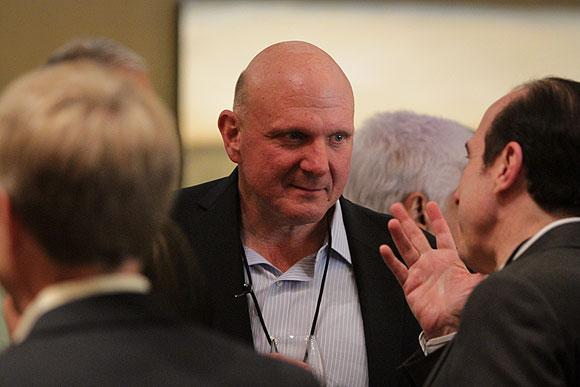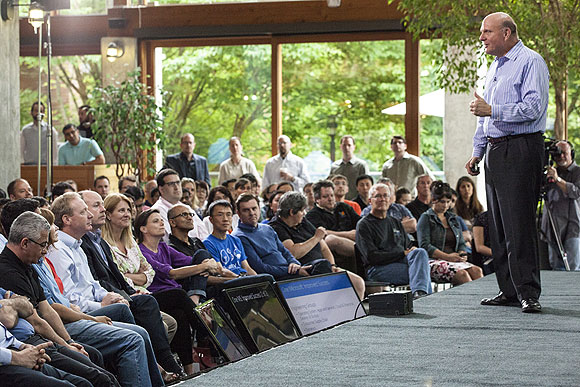Back in the spring of 2002, more than a decade ago, the big news coming out of Redmond was that Microsoft President Rick Belluzzo was leaving after 14 months on the job. But looking back today, with the benefit of hindsight, a different part of that announcement would turn out to have a far bigger impact on the company’s future.

Microsoft at the time decided to give “comprehensive operational and financial responsibility and greater accountability” to the leaders of its seven core divisions — further enabling those divisions to operate as businesses unto themselves.
“We realized we needed to give our core leaders deeper control and accountability in the way they run their businesses, while at the same time ensuring strong communication and collaboration across the business units,” said Microsoft CEO Steve Ballmer in a news release announcing the changes in April 2002.
It wouldn’t be the last time. Here’s what I wrote in September 2005 about that year’s reorg: “Microsoft will divide itself into three business divisions, each with its own president, trying to make its operational units more autonomous and its overall business more agile as it competes with the likes of Google and other smaller rivals.”
This was the end result, as famously portrayed in an online comic by BonkersWorld lampooning various tech company structures.
Microsoft insiders acknowledge the ring of truth in this parody. Rather than encouraging speed and collaboration across the company, the autonomy often put the divisions at odds.
This is what makes Microsoft’s latest reorganization, announced last week, so radically different. It’s not just another reorg. It’s a sudden reversal of the corporate structure that Ballmer himself put into place and repeatedly reinforced over the past decade.
Microsoft has shifted from a structure of comprehensive, end-to-end business units, organized largely around specific products, to what’s known in management circles as a “functional” organization — where groups are formed instead around their disciplines and the tasks they perform. That’s why, for example, the company’s new operating systems group includes not only engineering for Windows and Windows Phone but also for the Xbox operating system.

Ballmer explained the benefits in his memo to employees last week: “We are rallying behind a single strategy as one company — not a collection of divisional strategies. Although we will deliver multiple devices and services to execute and monetize the strategy, the single core strategy will drive us to set shared goals for everything we do. We will see our product line holistically, not as a set of islands.”
Ironically, many of the approaches in Ballmer’s new “One Microsoft” strategy are the same as those espoused by former Microsoft Windows president Steven Sinofsky, who wrote a book called “One Strategy” about functional organizations and the shift to this model in the Windows division under his leadership.
Sinofsky and Ballmer clashed over the best way to run the company, but the reorg almost makes it seem as Ballmer is now on the same page, literally.
For example, Ballmer told analysts last week: “The problem we’ve had in a sense — not the problem, but the opportunity we have — is if you subdivide the thing into too fine a set of parts you don’t think about your R&D investments as a general corporate resource that should be repurposed and used very broadly. It’s my resources, my business, and so this notion even from a P&L and resourcing perspective of getting to a more ‘One Microsoft’ strategy is very important.”
Assuming this is true, why did it take so long to figure out?
 Yes, Microsoft is different today than it was in 2002, and significantly larger, with nearly twice as many employees. The company says its evolution into a “devices and services” company — making both hardware and software — prompted the changes. Maybe it would have been too much to expect this type of foresight a decade ago.
Yes, Microsoft is different today than it was in 2002, and significantly larger, with nearly twice as many employees. The company says its evolution into a “devices and services” company — making both hardware and software — prompted the changes. Maybe it would have been too much to expect this type of foresight a decade ago.
But somewhere over the past 10 years, and long before this year, it must have become clear that the approach of autonomous divisions attempting to work together wasn’t working, as Microsoft failed to gain traction in key consumer markets, and Apple, with its functional structure, created a series of consumer hits.
One theory is that the U.S. antitrust settlement kept Microsoft from integrating in this way in the past, and that the expiration of that deal in 2011 cleared the way for this new structure, but Microsoft execs I’ve spoken with over the past week said that wasn’t a factor, at least not consciously.
Now the company is facing the decline of its traditional Windows PC business without a strong position in the booming markets for tablets and smartphones.
There will be — or at least there should be — tremendous pressure on the leaders of this new Microsoft organization to move quickly. This time, when they say the new org will make Microsoft more nimble and collaborative, they’d better hope it’s actually true.




